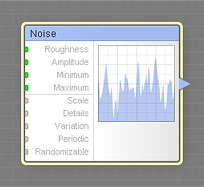
The Noise component generates a noise curve based on the Perlin noise algorithm. This is a curve component, it can be located in the Curves category on the Components Bar.
Roughness: Map Input
Defines the roughness of the noise curve. Technically, Roughness defines the relative contribution of the octaves comprising the noise to the final result (the number of octaves is controlled by the Details parameter). With Roughness of 0, only the first octave contributes to the result, which is equivalent to setting the Details parameter to 0. Low roughness, approximately 0 to 30, results in smoother noise because large-grained octaves have the greatest contribution to the final result. Higher roughness values increase the contribution of smaller-grained octaves, making the noise rougher. Roughness has no effect when Details is set to 0, because in this case only one octave is visible. Since Roughness is a map input, its value can be controlled separately for different image areas by connecting a map component to this input.
Lower Roughness can speed up the calculation – when the contribution of smaller-grained octaves is very close to zero, they are 'turned off' to save the time.
Amplitude: Map Input
Sets the amplitude of the curve within the range specified by the Minimum and Maximum parameters. The value ranges from 0 to 100. With the value of 0 the component generates a constant function ('flatline'), while the value of 100 results in the maximum amplitude. Since Amplitude is a map input, its value can be controlled separately for different image areas by connecting a map component to this input.
Note that with Amplitude values above 50 the output range of the curve may go beyond the maximum output range. To avoid clipping in such cases, the component compresses the curve peaks, making them smoother.
Minimum and Maximum: Map Inputs
Minimum and Maximum define the output range of the curve. When the Minimum value is greater than the Maximum value, they get reversed – the Minimum parameter defines the Maximum value and vice versa. This is needed to avoid turning the curve upside down. Since Minimum and Maximum are map inputs, their values can be controlled separately for different image areas by connecting a map component to any of these inputs.
Sets the scale of the curve by adjusting the noise frequency. The value ranges from 0 to 300.
Defines the complexity of the noise curve. Technically, Details sets the number of octaves the noise is composed of. Details of 0 means one octave, 20 means 3 octaves and 100 means 11 octaves. Details has no effect when Roughness is set to 0, because in this case only the first octave has 100% contribution to the result no matter how many octaves are active.
Large Details value leads to longer calculation times because it increases the number of octaves to calculate. For example, when Details is 0, only one octave is calculated. When Details is 100, eleven octaves are calculated. So if you don't need a high number of octaves, you can lower it to make the filter quicker.
Variation, technically known as random seed, affects the random aspects of the component which cannot be controlled directly: it randomizes the location and height of the curve feature points, or 'peaks'. If the Randomizable parameter is turned on, the randomization is also affected by the global Variation value. For more information, see How Variation Works.
When turned on, makes the curve periodic, or 'seamlessly tiled'. For example, if a periodic noise curve is connected to the Profile input of the Profile Gradient component, the output image will be fully seamless, while a non-periodic noise curve would produce discontinuities at the image edges.
When turned on, the global Variation parameter will affect the curve generated by the component. When this parameter is turned off, the global Variation has no effect on the curve. This may come in useful when you need to 'lock' the appearance of the curve and don't want the global Variation to change it.